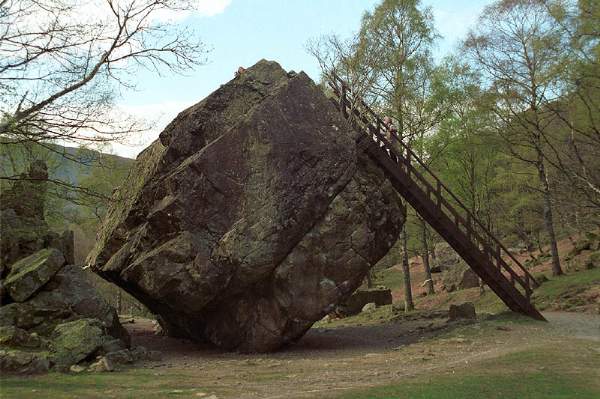
London (TAN): One of Lake District’s ‘quirkiest’ tourist attractions, a piece of rock, has been breathed life into by the United Kingdom-based National Trust, an independent organisation that conserves the country’s heritage and environment.
The massive Bowder Stone, near Keswick in The Lakes, rose to fame after a fragile ladder was added to the precariously-balanced rock by Joseph Pocklington way back in 1798. Not only did he set up the ladder for tourists to climb to the peak of the boulder, he also built a cottage, a ‘mock hermitage’ and placed a ‘druicial standing stone’ nearby to create an old-world ambience.
But the last ladder, reportedly set up in the 1980s, had become unsafe for use.
[ALSO READ: InterContinental Hotels Group uses artificial intelligence to curb food wastage]
The National Trust, which now takes care of the stone, has installed a new nine-metre metal earlier this week, recreating “the ‘airy’ feel of the original ladders that were leant up against the stone for the first tourists 200 years ago”, it said.
National Trust Curator Harvey Wilkinson said: “This is about restoring the excitement of a visit to one of the strangest and at one time, the most famous Lake District attraction. The Bowder Stone is a powerful reminder of change in the landscape, viewed through the eyes of the painters, poets and writers who portrayed it. In that sense it is something of a time machine, revealing changes in its setting, and also in peoples’ perception over time.”
Approximately nine metres high and 15 metres wide, the Bowder Stone is about six times the height of a person. The enormous rock, weighing about 1,253 tonnes, is said to have fallen from the crags above after the last ice age. It then stationed itself at its present angle which gives the rock the feeling of looming over one’s head, creating the aura of danger which had become popular with Georgian tourists who lapped the romantic setting alongside a sense of fear.
“When the Victorians stood on the top of the stone they would have been able to clearly see the high and central fells,” said Jessie Binns, National Trust Visitor Experience and Engagement Manager.

“However, today’s visitor will instead find themselves surrounded by tree tops, mostly birch and oak. And, depending on the time of the year, they may also see and hear woodpeckers, tawny owls and large dragonflies like the spectacular golden-ringed dragonfly hunting for insects in the tree canopy,” Binns added.
[ALSO READ: Northern Ireland get its (digital) version of Mount Rushmore ahead of 148th Open]
The new ladder, that allows tourists to reach the summit, was designed in collaboration with the World Heritage Site partnership and British metalwork designer Chris Brammall. The design also incorporates a curved profile on the back edge of each step so that climbers can “warm up their muscles by climbing the ladder hand-over-hand”.




